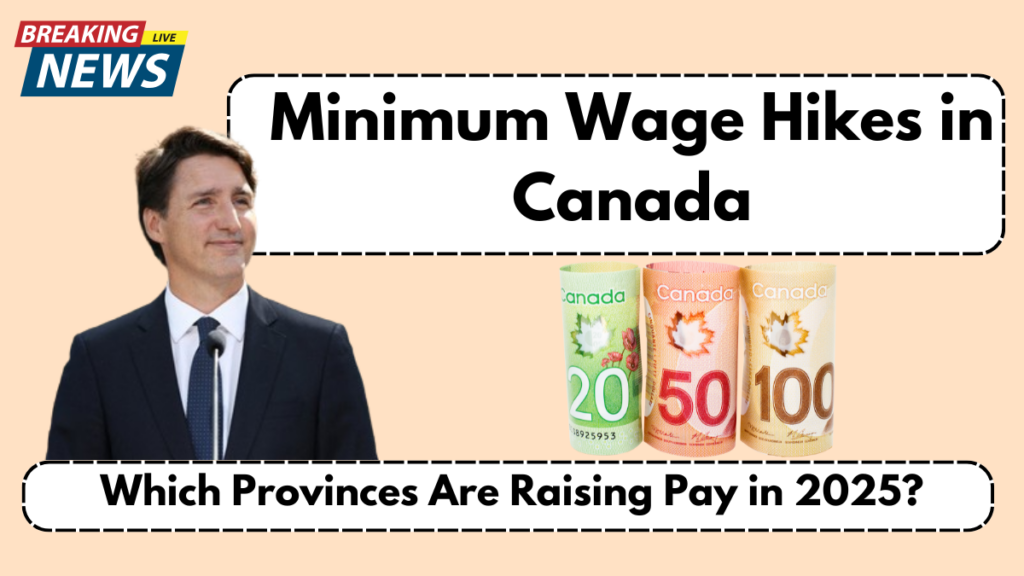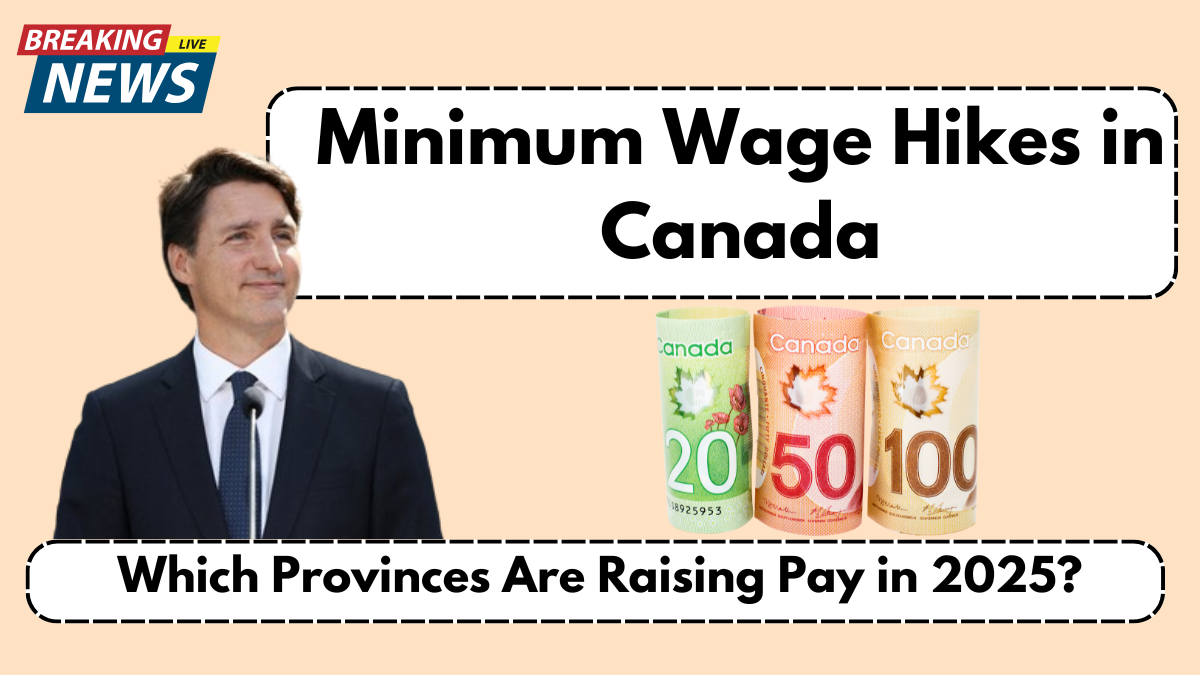Canada’s minimum wage policies have always been a significant part of its economic structure, ensuring that workers receive fair compensation for their labor. As inflation and the cost of living continue to rise, Canadian provinces and territories are adjusting their minimum wage rates to keep up. In 2025, a number of key regions will implement notable wage increases. These pay raises are crucial in helping workers cope with inflation, ensuring fair remuneration across various industries.
While Canada has a federal minimum wage, its application is largely limited to employees in federally regulated industries such as banks, postal services, and Crown corporations. However, the power to set minimum wages for workers outside these sectors rests with each province and territory. This decentralized system means that the rates can vary significantly across Canada, reflecting the diverse economic conditions in each region.

Minimum Wage Increases in Canada: A Response to Inflation and Living Costs
In 2025, Canada will see a range of increases in minimum wage rates across multiple provinces and territories. This response to the ongoing economic pressure caused by inflation and rising living expenses demonstrates the government’s commitment to supporting workers and maintaining economic stability. The decision to raise wages is a direct reaction to the escalating cost of living, which affects all Canadians but hits the lowest-paid workers the hardest.
The minimum wage system in Canada is reviewed regularly, with adjustments made to ensure that it reflects current economic conditions. These adjustments are primarily linked to the Consumer Price Index (CPI), which tracks the cost of goods and services. By tying the minimum wage to inflation, Canada ensures that wages keep pace with the rising costs of living, enabling workers to maintain their purchasing power.
Why Are Minimum Wages Rising in 2025?
Several factors contribute to the 2025 minimum wage increases across Canada. The most significant is inflation, which has pushed up the cost of essential goods and services such as food, housing, and healthcare. These increases have strained household budgets, especially for low-income workers. To help workers keep pace with these growing expenses, both federal and provincial governments have raised minimum wage levels.
In addition to inflation, the rising cost of housing has particularly impacted low-wage workers in urban areas. As rents and property prices continue to climb, workers need higher wages to afford basic living expenses. Furthermore, many sectors, including retail, hospitality, and services, have struggled with stagnating wages, contributing to growing income inequality. Raising the minimum wage is an important step toward addressing these disparities and ensuring that workers can maintain a decent standard of living.
Expected Minimum Wage Increases Across Canada in 2025
Several provinces and territories in Canada will experience significant minimum wage increases in 2025. Below is a comprehensive table outlining the expected wage changes, their effective dates, and the new minimum wage rates in each jurisdiction:
| Province/Territory | Current Minimum Wage | Expected Minimum Wage | Effective Date |
|---|---|---|---|
| New Brunswick | $15.30 | $15.77 | April 1, 2025 |
| Nova Scotia | $15.00 | $15.40 | April 1, 2025 |
| Newfoundland & Labrador | $15.60 | $15.91 | April 1, 2025 |
| Yukon | $17.59 | $17.97 | April 1, 2025 |
| Quebec | $15.75 | To be updated soon | May 1, 2025 |
| British Columbia | $17.40 | To be updated soon | June 1, 2025 |
| Northwest Territories | $16.05 | To be updated soon | September 2025 |
| Ontario | $17.20 | $17.82 | October 1, 2025 |
These increases will ensure that workers in Canada receive fair compensation in line with the rising cost of living.
Understanding Canada’s Minimum Wage System
Canada’s minimum wage is the lowest hourly rate that employers are legally required to pay their employees. While the federal government sets a base rate for employees working in federally regulated sectors, each province and territory sets its own minimum wage for workers in non-federally regulated sectors. This means that wage levels vary across the country based on local economic conditions.
For example, the federal minimum wage applies to workers in sectors like banking, postal services, and interprovincial transportation. As of 2025, the federal minimum wage is expected to be approximately $17.30 per hour. However, the actual wage rates vary by province and territory, with some areas implementing higher wages due to local economic conditions.
Why These Increases Are Crucial for Workers
The increases in minimum wage are not just about keeping pace with inflation—they are about ensuring that workers, particularly those in lower-paying jobs, can afford basic necessities such as food, housing, and transportation. As the cost of living rises, wages must follow suit to maintain workers’ standard of living. For many workers in sectors such as retail and hospitality, the wage hikes are essential in helping them stay afloat financially.
Moreover, higher wages also have a broader impact on the economy. When workers earn more, they have more disposable income, which in turn boosts consumer spending. This can lead to stronger economic growth, as businesses benefit from increased demand for goods and services. Additionally, raising the minimum wage can help reduce income inequality by ensuring that low-paid workers receive a fairer share of the economic pie.
Conclusion
In 2025, minimum wage increases across Canada represent an important step in addressing the economic challenges faced by workers, particularly those in lower-paying jobs. These increases are necessary to ensure that workers can keep up with the rising cost of living and maintain their purchasing power. As inflation continues to drive up living costs, these wage hikes will play a critical role in ensuring that workers can meet their basic needs and maintain a decent standard of living.
FAQ
What is the federal minimum wage in Canada for 2025?
The federal minimum wage in Canada is expected to be around $17.30 per hour in 2025, though this only applies to workers in federally regulated sectors such as postal services and banking.
Which provinces are increasing their minimum wage in 2025?
Provinces such as New Brunswick, Nova Scotia, Newfoundland & Labrador, Yukon, Quebec, British Columbia, Northwest Territories, and Ontario will all see increases in their minimum wage in 2025.
Why are minimum wages increasing in Canada in 2025?
The increases are primarily in response to rising inflation and the growing cost of living, which has made it more difficult for workers to afford basic necessities. These changes aim to help workers maintain their purchasing power.
How does the minimum wage affect workers in Canada?
The minimum wage directly impacts workers by ensuring they receive fair pay for their labor, particularly those in lower-wage sectors. Higher wages help workers meet their living expenses and improve their quality of life.
How often is the minimum wage adjusted in Canada?
Minimum wage rates in Canada are typically adjusted annually, often in line with inflation and changes in the Consumer Price Index (CPI). These adjustments are made to ensure that wages keep pace with the cost of living.
For More Information Click Here
Pari is a passionate writer known for captivating stories that blend imagination and reality. Inspired by travel, history, and everyday moments, Pari crafts narratives that resonate deeply with readers.




